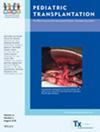Chronotropic Response to Exercise is Decreased in Patients With Congenital Heart Disease Compared to Cardiomyopathy Following Pediatric Heart Transplantation
IF 1.4
4区 医学
Q3 PEDIATRICS
引用次数: 0
Abstract
BackgroundTwo common indications for pediatric heart transplantation are congenital heart disease and cardiomyopathy. Prior studies suggest differences in chronotropy on cardiopulmonary exercise testing outcomes depending on indication for heart transplantation. We aimed to determine whether the number of pretransplant sternotomies is associated with differences in heart rate response during exercise testing.MethodsA retrospective analysis of our institutional pediatric heart transplant data between 2004 and 2022 was performed. Patients were categorized by indication for transplantation into a cardiomyopathy (CM) group if they had a congenital or acquired cardiomyopathy or a congenital heart disease (CHD) group including all other forms of congenital cardiac anatomic abnormalities.ResultsCHD patients (与心肌病患者相比,先天性心脏病患者在接受小儿心脏移植手术后对运动的顺时针反应减弱
背景小儿心脏移植的两个常见适应症是先天性心脏病和心肌病。先前的研究表明,心脏移植适应症不同,心肺运动测试结果的时序性也不同。我们的目的是确定移植前胸骨切开术的次数是否与运动测试期间心率反应的差异有关。方法对本机构 2004 年至 2022 年期间的小儿心脏移植数据进行了回顾性分析。结果CHD患者(n = 40)与CM患者(n = 53)在移植前胸骨切开的平均次数上存在差异(2.4 ± 1.8 vs. 0.5 ± 0.9,p < 0.001)。超声心动图功能和导管血流动力学无明显差异。在心肺运动测试表现方面,先天性心脏病组的静息心率显著较高(91.8 ± 11.2 vs. 86.4 ± 10.2 bpm,p = 0.019),达到的年龄预测最大心率百分比较低(78.3 ± 8.5% vs. 83.2 ± 11.4%, p = 0.032),心率储备较低(68.6 ± 19.8 vs. 84.4 ± 24.0 bpm, p = 0.001),尽管年龄和平均移植时间相似。回归分析证实,移植前胸骨切开术的次数是预测心率指标的主要因素。两组患者的胸骨切开次数差异很大,这可能支持了一种假设,即之前的手术破坏了心脏神经支配,可能会导致移植后对运动的时向反应减弱。
本文章由计算机程序翻译,如有差异,请以英文原文为准。
求助全文
约1分钟内获得全文
求助全文
来源期刊

Pediatric Transplantation
医学-小儿科
CiteScore
2.90
自引率
15.40%
发文量
216
审稿时长
3-8 weeks
期刊介绍:
The aim of Pediatric Transplantation is to publish original articles of the highest quality on clinical experience and basic research in transplantation of tissues and solid organs in infants, children and adolescents. The journal seeks to disseminate the latest information widely to all individuals involved in kidney, liver, heart, lung, intestine and stem cell (bone-marrow) transplantation. In addition, the journal publishes focused reviews on topics relevant to pediatric transplantation as well as timely editorial comment on controversial issues.
 求助内容:
求助内容: 应助结果提醒方式:
应助结果提醒方式:


